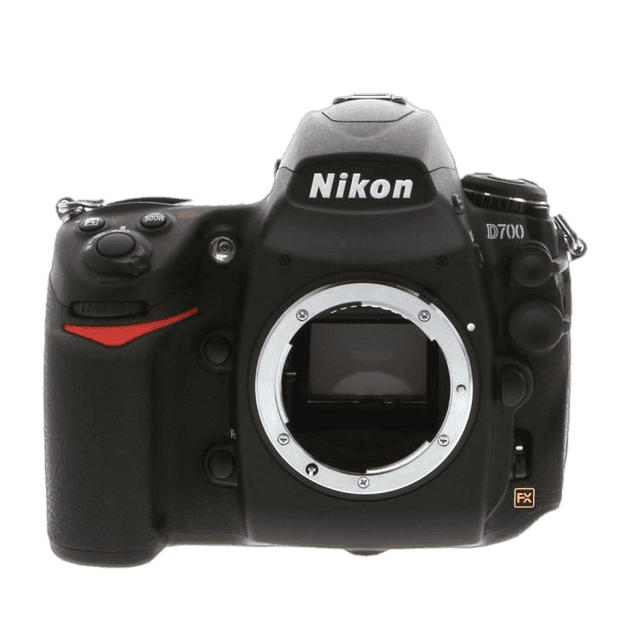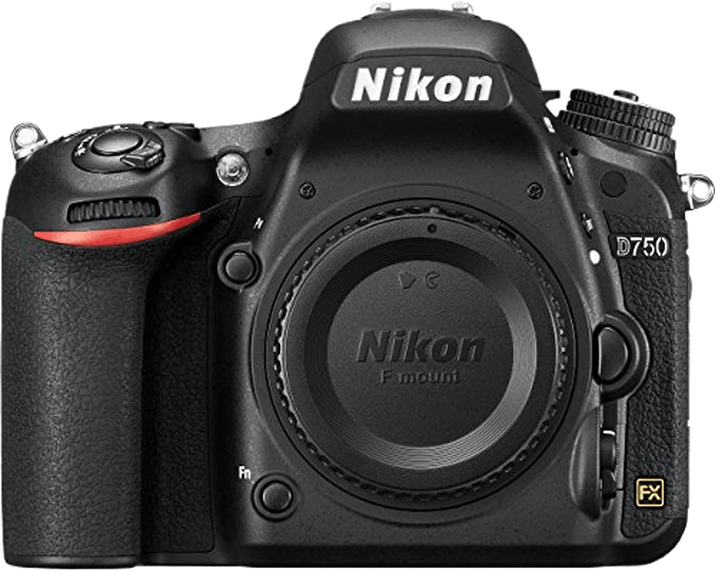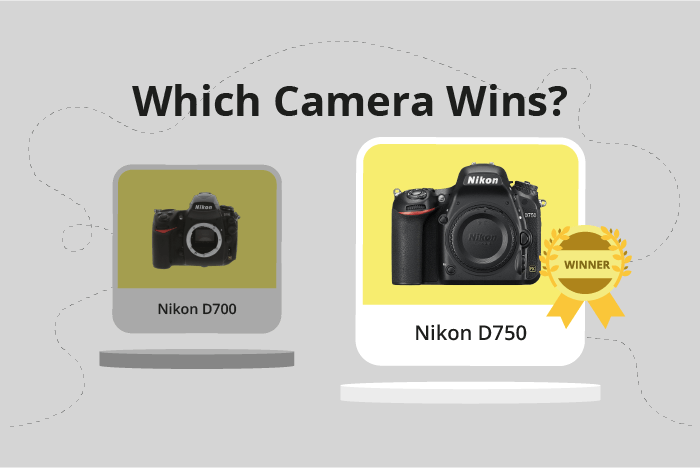Nikon D700 vs D750 Comparison
Nikon D700

Nikon D750

The Nikon D750 emerges as the winner with a score of 68/100, outperforming the Nikon D700, which scores 53/100. Both cameras are DSLRs, announced in 2014 and 2008 respectively. They share common features, such as the camera type and general design.
The D750 surpasses the D700 in terms of a more compact size (141 x 113 x 78mm) and lighter weight (750g / 1.65lbs), making it more convenient for users. Additionally, it offers better value with a lower launch price of $2300 compared to the D700’s $2699.
However, the D700 still holds its ground with a slightly larger body (147 x 123 x 77mm) and a heavier build (1074g / 2.37lbs), which some photographers may prefer for stability and durability.
Taking all factors into account, the Nikon D750 proves to be a better choice due to its higher score, compact size, and affordability, while the D700 may appeal to those who prioritize a more robust build.
Nikon D700 vs D750 Overview and Optics
The Nikon D750 outperforms the Nikon D700 in optics, scoring 71 out of 100 compared to the D700’s 54 points. Both cameras share several common specifications, such as the CMOS sensor type, full-frame sensor size, Nikon F FX lens mount, and lack of image stabilization. However, the D750 excels in various aspects, contributing to its higher score.
The D750 boasts a higher megapixel count of 24.3 compared to the D700’s 12.1, providing better image resolution and detail. Additionally, the D750 features an upgraded Expeed 4 processor, which enhances image processing capabilities and ensures improved image quality. Furthermore, the D750’s sensor has a DXOMARK score of 93, significantly surpassing the D700’s 80 points. This higher score translates to better overall image quality, dynamic range, and low-light performance.
On the other hand, the D700 has a faster shooting speed of 8 frames per second (fps), compared to the D750’s 6.5 fps. This advantage is beneficial for action and sports photography, where capturing fast-moving subjects is crucial. However, this is the only area where the D700 surpasses the D750 in terms of optics.
Taking all factors into account, the Nikon D750 is the clear winner in terms of optics. Its higher megapixel count, upgraded processor, and superior DXOMARK sensor score provide better overall image quality, detail, and low-light performance. While the D700’s faster shooting speed offers an advantage for certain photography styles, it is not enough to outweigh the D750’s optical superiority. Therefore, the Nikon D750 is the better choice for photographers seeking superior optical performance.
Nikon D700 vs D750 Video Performance
When comparing the video capabilities of the Nikon D700 and the Nikon D750, it is important to note that the Nikon D700 does not have any video functionality. This means that the D700 cannot record video, and therefore, cannot be directly compared to the D750 in terms of video performance.
The Nikon D750, on the other hand, has a video score of 56 out of 100. This camera can record Full HD videos with a maximum resolution of 1920 x 1080 pixels. The maximum video frame rate that the D750 can achieve is 60fps, allowing for smooth video playback. However, the D750 does not have built-in time-lapse functionality.
To sum up, the Nikon D700 lacks video capabilities, making it unsuitable for those who require video recording features in their camera. Conversely, the Nikon D750 offers Full HD video recording with a decent video score, making it a more appropriate choice for users who need both photography and videography features in their camera.
Nikon D700 vs D750 Features and Benefits
The Nikon D750 outperforms the Nikon D700 with a feature score of 59/100 compared to the D700’s 54/100. Both cameras share some common specifications, including a 3-inch screen size for the D700 and a 3.2-inch screen size for the D750, absence of a touchscreen, no GPS, and no Bluetooth. However, the D750 surpasses the D700 in several aspects, making it the superior choice.
The D750 excels with a higher screen resolution of 1,229,000 dots compared to the D700’s 922,000 dots, providing a sharper and clearer display. Additionally, the D750 is equipped with a flip screen, a feature absent in the D700. This allows for more flexibility when composing shots, especially in difficult or awkward angles. Both cameras have WIFI capabilities, enabling wireless transfer of photos and remote control through a smartphone.
The D700, despite having a lower feature score, still holds its ground in certain areas. It maintains a solid screen size of 3 inches and offers WIFI connectivity, which is a valuable feature for modern photographers. However, the lack of a flip screen and lower screen resolution limit its overall appeal compared to the D750.
Considering the comparison of these two cameras, the Nikon D750 stands out as the better option due to its higher feature score, larger screen size, flip screen, and enhanced screen resolution. The D700, although a decent choice, falls short in providing the same level of versatility and quality as the D750. Consequently, the Nikon D750 is the recommended choice for photographers seeking a camera with superior features and performance.
Nikon D700 vs D750 Storage and Battery
The Nikon D750 outperforms the Nikon D700 in storage and battery with a score of 79/100, while the D700 scores 43/100. Both cameras lack USB charging, but they differ in other aspects.
The D750 excels with dual memory card slots, accepting SD, SDHC, and SDXC cards, offering more flexibility and storage options. Additionally, it has a longer battery life of 1230 shots, using the EN-EL15 battery type. These features make the D750 more suitable for extended shooting sessions and various storage requirements.
The D700, on the other hand, has a single memory card slot, compatible with Compact Flash (Type I) cards only. Its battery life is shorter, providing 1000 shots with the EN-EL3e battery type. This may limit the camera’s usability in certain situations.
Considering these points, the Nikon D750 proves to be superior in storage and battery capabilities. However, the D700 may still be a viable option for photographers who do not require extensive battery life and storage flexibility.
Nikon D700 vs D750 – Our Verdict
Are you still undecided about which camera is right for you? Have a look at these popular comparisons that feature the Nikon D700 or the Nikon D750:

